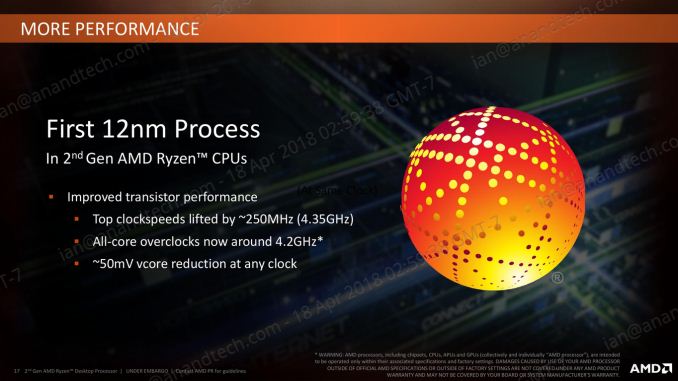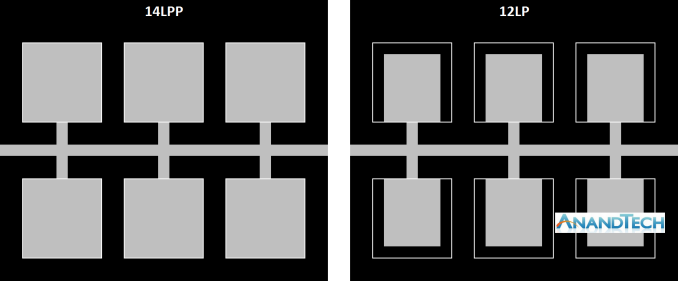The AMD 2nd Gen Ryzen Deep Dive: The 2700X, 2700, 2600X, and 2600 Tested
by Ian Cutress on April 19, 2018 9:00 AM ESTTalking 12nm and Zen+
One of the highlights of the Ryzen 2000-series launch is that these processors use GlobalFoundries’ 12LP manufacturing process, compared to the 14LPP process used for the first generation of Ryzen processors. Both AMD and GlobalFoundries have discussed the differences in the processes, however it is worth understanding that each company has different goals: AMD only needs to promote what helps its products, whereas GlobalFoundries is a semiconductor foundry with many clients and might promote ideal-scenario numbers. Earlier this year we were invited to GlobalFoundries Fab 8 in upstate New York to visit the clean room, and had a chance to interview Dr. Gary Patton, the CTO.
The Future of Silicon: An Exclusive Interview with Dr. Gary Patton, CTO of GlobalFoundries
In that interview, several interesting items came to light. First, that the CTO doesn’t necessarily have to care much about what certain processes are called: their customers know the performance of a given process regardless of the advertised ‘nm’ number based on the development tools given to them. Second, that 12LP is a series of minor tweaks to 14LPP, relating to performance bumps and improvements that come from a partial optical shrink and a slight change in manufacturing rules in the middle-line and back-end of the manufacturing process. In the past this might not have been so news worthy, however GF’s customers want to take advantage of the improved process.
Overall, GlobalFoundries has stated that its 12LP process offers a 10% performance improvement and a 15% circuit density improvement over 14LPP.
This has been interpreted in many ways, such as an extra 10% frequency at the same power, or lower power for the same frequency, and an opportunity to build smaller chips.
As part of today’s launch, AMD has clarified what the move to 12LP has meant for the Ryzen 2000-series:
- Top Clock Speeds lifted by ~250 MHz (~6%)
- All-core overclocks around 4.2 GHz
- ~50 mV core voltage reduction
AMD goes on to explain that at the same frequency, its new Ryzen 2000-series processors draw around 11% less power than the Ryzen 1000-series. The claims also state that this translates to +16% performance at the same power. These claims are a little muddled, as AMD has other new technologies in the 2000-series which will affect performance as well.
One interesting element is that although GF claims that there is a 15% density improvement, AMD is stating that these processors have the same die size and transistor count as the previous generation. Ultimately this seems in opposition to common sense – surely AMD would want to use smaller dies to get more chips per wafer?
Ultimately, the new processors are almost carbon copies of the old ones, both in terms of design and microarchitecture. AMD is calling the design of the cores as ‘Zen+’ to differentiate them to the previous generation ‘Zen’ design, and it mostly comes down to how the microarchitecture features are laid out on the silicon. When discussing with AMD, the best way to explain it is that some of the design of the key features has not moved – they just take up less area, leaving more dark silicon between other features.
Here is a very crude representation of features attached to a data path. On the left is the 14LPP design, and each of the six features has a specific size and connects to the bus. Between each of the features is the dark silicon – unused silicon that is either seen as useless, or can be used as a thermal buffer between high-energy parts. On the right is the representation of the 12LP design – each of the features have been reduced in size, putting more dark silicon between themselves (the white boxes show the original size of the feature). In this context, the number of transistors is the same, and the die size is the same. But if anything in the design was thermally limited by the close proximity of two features, there is now more distance between them such that they should interfere with each other less.
For reference, AMD lists the die-size of these new parts as 213mm2, containing 4.8 billion transistors, identical to the first generation silicon design. AMD confirmed that they are using 9T transistor libraries, also the same as the previous generation, although GlobalFoundries offers a 7.5T design as well.
So is Zen+ a New Microarchitecture, or Process Node Change?
Ultimately, nothing about most of the Zen+ physical design layout is new. Aside from the manufacturing process node change and likely minor adjustments, the rest of the adjustments are in firmware and support:
- Cache latency adjustments leading to +3% IPC
- Increased DRAM Frequency Support to DDR4-2933
- Better voltage/frequency curves, leading to +10% performance overall
- Better Boost Performance with Precision Boost 2
- Better Thermal Response with XFR2













545 Comments
View All Comments
Aichon - Tuesday, April 24, 2018 - link
Wouldn’t it actually suggest that there’s a difference between your setup and theirs that favors yours? For instance, in the case of your earlier benchmark, you admittedly overclocked your 1600X and they didn’t, so don’t you think that might account for the 10% difference you saw over theirs? And in the case of the 8700K, you omitted key contextual information (e.g. is your system updated, and if so, which updates to what components?) that would allow others to verify that it was an apples-to-apples comparison.Ryan may very well have made a mistake and you may very well be entirely correct about all of this, but claiming he’s a liar on the basis of your overclocked system and then following it up with claims about the 8700K that lack the information necessary for someone else to verify your data does not help your case.
Meanwhile, my horse in this race died years ago. The latest product I bought from either teams red or blue was a 2011 Mac Mini that had an Intel CPU and an AMD GPU. All of which is to say, I’m a fan of passionate debate, but let’s keep aspersions to a minimum and focus on getting to the truth.
tn_techie - Thursday, April 19, 2018 - link
On the first paragraph, Ian writes the following:"This is not AMD’s next big microarchitecture, which we know is called Rome (or Zen 2) on 7nm."
That is incorrect. Rome is the codename for the upcoming EPYC 2nd Gen CPUs that will replace the current Naples products, and not the codename for AMD's next gen CPU core arch.
msroadkill612 - Thursday, April 19, 2018 - link
"anything that is hard on a single-threaded, such as our FCAT test or Cinebench 1T, Intel wins hands down"Yeah, I know, its just an indicator, but it's telling that the test seems as silly as the emphasis on ipc due to shrill/shill gamers - who would use single thread for cinebench?
Luckz - Monday, April 23, 2018 - link
Single thread Cinebench 15 score is *the* indicator of IPC used in meme-filled debates on online forums. It's just an important metric right now. And unlike, uh, GeekBench, CPU-Z, and whatever else claims to judge single thread score, it's pretty accurate.peevee - Thursday, April 19, 2018 - link
"ranging from the Silent 65W Wraith models"You mean Stealth, right?
Ryan Smith - Thursday, April 19, 2018 - link
Indeed we do. Thanks!fallaha56 - Thursday, April 19, 2018 - link
Techradar also confirming massive performance hit from Intel patchesEg 1000points in single core Geekbench
ACE76 - Thursday, April 19, 2018 - link
Techradar has AMD beating Intel in pretty much everything...I guess Intel fanboys could just run their systems unpatched and claim to be kings...lol.msroadkill612 - Thursday, April 19, 2018 - link
My memory is bad, but not that bad.I read a lot of cpu reviews, and this is the first that has made it clear that these are post security patch.
Could this be the first honest comparison review of ryzen - new OR old?
It certainly stirred a fanboi wasp nest.
ACE76 - Thursday, April 19, 2018 - link
Anandtech isn't alone... Techradar has AMD winning on fully patched systems as well...the sites that have Intel winning are using either old scores or unpatched systems for Smeltdown.